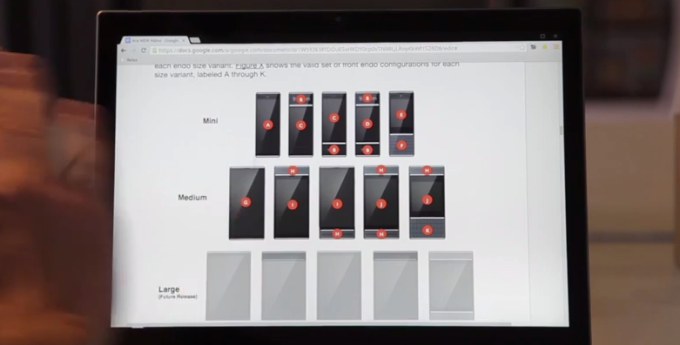
Google has released a video (embedded below) showing a glimpse of what’s going on behind the scenes at Project Ara, one of the hardware shunkworks projects coming out of its Advanced Technology and Projects (ATAP). The ATAP group is also working on a 3D mapping handset which Google showed off in February, called Project Tango.
Project Ara is the codename for the modular phone concept that Motorola was working on, and which Google retained when it sold the rest of Motorola Mobility to Lenovo.
As Google’s moonshots go, Project Ara is relatively tame — compared to Project Loon‘s connectivity balloons, say. Or the biggie, Calico: Google’s attempt to hack death.
But deconstructing the complexity of a smartphone and refashioning it as a bunch of swappable components which can be slotted together in various custom combinations by the user is clearly no cake walk.
Nor is getting people to grok the concept of speccing out their own phone in hardware terms. (Although, really, when you think about it, the modular hardware concept is much like the modular software that users are now very comfortable with — aka apps.)
Designing an interface to explain the modular smartphone concept to users is something the video touches on, with an Ara configurator app shown to be in the works. ”We’re really trying to make this interface as simple as possible, and as spacially intuitive as we can,” says Eric Gunther, co-founder of SoSo Ltd, an interactive design studio that’s working with Google’s ATAP on the design of this app.
The connecting force Google is going to use to bind all the phone blocks in each modular device is magnetism. Or “electro-permanent magnetism”, as the video puts it — which presumably means the magnetism is switched on when you want the device to stay together, and off when you want to swap out components.
Making sure those connections are robust enough for everyday use is going to be a key requirement of the Ara project. Things fall apart, sure; but smartphone owners aren’t going to want their phone to do so in their jacket pocket.


The video also includes a view of the metal exoskeleton where prototype modules are being tested by the ATAP team:
Plus, there’s a glimpse of how different size configurations of the modular device might look in terms of end-user design — with phablet, standard and small handsets being specced out – albeit, in render form at this nascent stage:
The most interesting thing about the video — which very much has the feel of a crowdfunding pitch video you might find on Kickstarter or Indiegogo — is that Google is clearly continuing to put marketing muscle behind Project Ara to try to get outsiders excited about the prospect of a modular device.
It’s running a two-day developer conference for the device this month, which likely explains the release timing of this video.
The conference is the first in a series planned for this year, with the first event focusing on the alpha release of the Ara Module Developers’ Kit (MDK) — to get developers building Ara modules. More events are planned, so expect more details about Ara to keep dropping, piece by piece. source by TC.















0 comments :
Post a Comment
Thanx for all your Feedback .... and don't post to promote your site's ...
I kept the option as Comment moderation mode. So if you try to promote your site from here.. I do delete your comment's ..